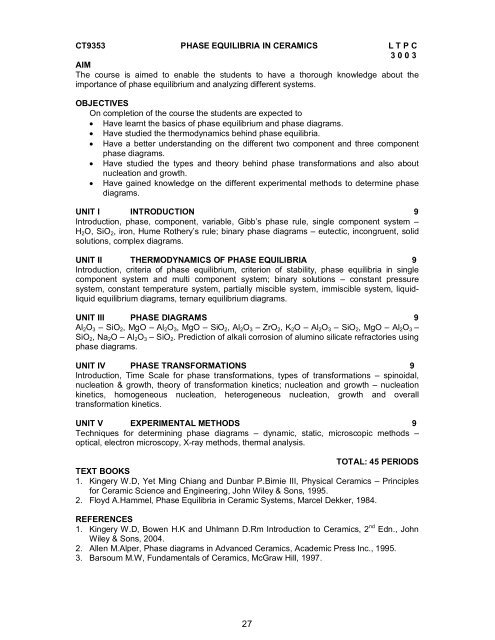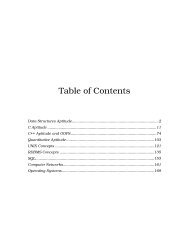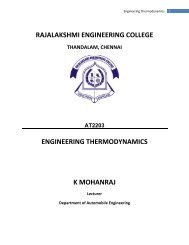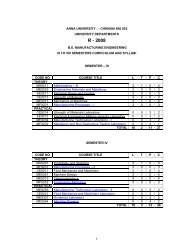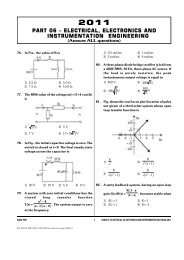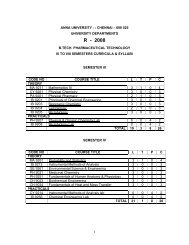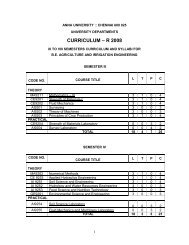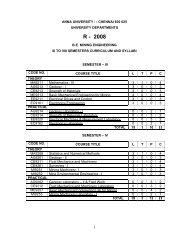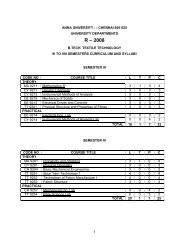b.tech. ceramic technology - Technicalsymposium
b.tech. ceramic technology - Technicalsymposium
b.tech. ceramic technology - Technicalsymposium
You also want an ePaper? Increase the reach of your titles
YUMPU automatically turns print PDFs into web optimized ePapers that Google loves.
CT9353 PHASE EQUILIBRIA IN CERAMICS L T P C3 0 0 3AIMThe course is aimed to enable the students to have a thorough knowledge about theimportance of phase equilibrium and analyzing different systems.OBJECTIVESOn completion of the course the students are expected to Have learnt the basics of phase equilibrium and phase diagrams. Have studied the thermodynamics behind phase equilibria. Have a better understanding on the different two component and three componentphase diagrams. Have studied the types and theory behind phase transformations and also aboutnucleation and growth. Have gained knowledge on the different experimental methods to determine phasediagrams.UNIT I INTRODUCTION 9Introduction, phase, component, variable, Gibb’s phase rule, single component system –H 2 O, SiO 2 , iron, Hume Rothery’s rule; binary phase diagrams – eutectic, incongruent, solidsolutions, complex diagrams.UNIT II THERMODYNAMICS OF PHASE EQUILIBRIA 9Introduction, criteria of phase equilibrium, criterion of stability, phase equilibria in singlecomponent system and multi component system; binary solutions – constant pressuresystem, constant temperature system, partially miscible system, immiscible system, liquidliquidequilibrium diagrams, ternary equilibrium diagrams.UNIT III PHASE DIAGRAMS 9Al 2 O 3 – SiO 2 , MgO – Al 2 O 3 , MgO – SiO 2 , Al 2 O 3 – ZrO 2 , K 2 O – Al 2 O 3 – SiO 2 , MgO – Al 2 O 3 –SiO 2 , Na 2 O – Al 2 O 3 – SiO 2 . Prediction of alkali corrosion of alumino silicate refractories usingphase diagrams.UNIT IV PHASE TRANSFORMATIONS 9Introduction, Time Scale for phase transformations, types of transformations – spinoidal,nucleation & growth, theory of transformation kinetics; nucleation and growth – nucleationkinetics, homogeneous nucleation, heterogeneous nucleation, growth and overalltransformation kinetics.UNIT V EXPERIMENTAL METHODS 9Techniques for determining phase diagrams – dynamic, static, microscopic methods –optical, electron microscopy, X-ray methods, thermal analysis.TOTAL: 45 PERIODSTEXT BOOKS1. Kingery W.D, Yet Ming Chiang and Dunbar P.Birnie III, Physical Ceramics – Principlesfor Ceramic Science and Engineering, John Wiley & Sons, 1995.2. Floyd A.Hammel, Phase Equilibria in Ceramic Systems, Marcel Dekker, 1984.REFERENCES1. Kingery W.D, Bowen H.K and Uhlmann D.Rm Introduction to Ceramics, 2 nd Edn., JohnWiley & Sons, 2004.2. Allen M.Alper, Phase diagrams in Advanced Ceramics, Academic Press Inc., 1995.3. Barsoum M.W, Fundamentals of Ceramics, McGraw Hill, 1997.27


